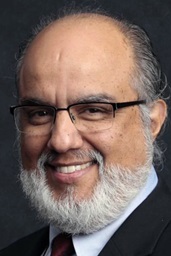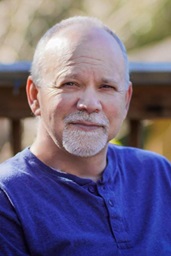Their experience is challenging the gospel truth, “The first shall be last and the last shall be first.”
They are those seated in what the Rev. Laurie Haller, clergy delegate, has named the “very, very, very last row of the voting area of the Tampa Convention Center, where the people on the stage look like flesh-colored ants.”
Haller is part of the West Michigan Annual (regional) Conference delegation. Sharing her table is Emily Just, a lay delegate from Denmark. “It is 90 meters (300 feet) from the stage to our table,” Just noted. “I have trouble seeing the bishop, so I know she has trouble seeing me.”
Haller likens the experience in the rear of the auditorium to the many United Methodists who prefer to sit in the back pews on Sunday morning. “Except,” she said, “unlike most back pew sitters, we really do want to be noticed … so that we can be a part of the process and share our wisdom.”
Just feels a similar disenfranchisement. “I am frustrated. I come from a small annual conference where you can see all and hear all.” She said these difficulties are felt within the context of a larger European concern that “we are not able to share our case” in the global arena.
So how does it look and feel from the other end of the auditorium?
The Secretary of the General Conference is the Rev. L. Fitzgerald “Gere” Reist II. He explains that this is the first General Conference arranged at round tables, which has presented more of a challenge when it comes to line of sight. A rotation has been formally established and observed that moves systematically around the room with regard to who is called to the microphones. Colored cards indicate whether the delegate has a question, motion or point of order.
“We do our best,” Reist said, “but it’s particularly difficult in that back left section.” Unexpected circumstances can foul the best plan. “From the stage, at that distance an orange card becomes invisible when raised in the midst of persons wearing orange T-shirts.”
So how does the system work out at a practical level? On stage, one bishop holds opera glasses to his eyes to extend his view to the far reaches of the bar. He’s one of the spotters assisting his colleague in the chair. Bishop Janice Riggle Huie, presiding during the May 2 morning session, commented afterward that she turned to those behind her to make sure persons were not being missed and that the rotation did not get stalled.
“It’s very hard to see,” she said. “I’m trying to be sure to get around the room but it seems like everyone is waving.”
Haller, one of those card wavers, spent all day May 1 trying to be recognized by waving the official white card without success. That called for some innovative measures. She fashioned “a larger sign with two ‘No More Malaria’ flyswatters and Commission on the Status and Role of Women stickers,” Haller celebrates. “I was finally seen and invited to make my motion.”
Her tablemate, Emily Just, suggests that such solutions, though creative, should not be necessary in a 21st century environment. “We live in an electronic time,” she says. “This just feels so old-fashioned to me.”
Additional monitors, different table arrangement, a higher stage, and spotters in the back all are “better” ideas for the future being proposed by the “back-row buddies” seated around Haller.
“We know that our leaders care about us,” Haller said. “It’s just that we’re so far away no one can see us … we can do a song and dance, with absolutely no effect.”
Still she concedes that the frustrations in the last row of General Conference constitute a learning experience. “I may be in the back row, but I still remain within the (delegate) bar. I will never know the fear and despair of those … who are utterly powerless.”
Kay DeMoss is senior writer for the West Michigan Conference Daily News
Like what you're reading? Support the ministry of UM News! Your support ensures the latest denominational news, dynamic stories and informative articles will continue to connect our global community. Make a tax-deductible donation at ResourceUMC.org/GiveUMCom.




